The effectiveness of conservative interventions on temporomandibular disorder-related kinesiophobia and pain catastrophizing: a systematic review
IF 2.2
3区 医学
Q1 REHABILITATION
引用次数: 0
Abstract
Background
Temporomandibular disorders (TMD) are prevalent conditions that can significantly impact function and quality of life. Pain catastrophizing and kinesiophobia contribute to temporomandibular disorder-related disability.
Aims
Evaluate the effectiveness of conservative interventions on kinesiophobia and pain catastrophizing in adults with temporomandibular disorders.
Methods
PubMed, Embase, CINAHL and Cochrane Central were searched for peer-reviewed interventional studies evaluating the effect of non-pharmacological conservative interventions on kinesiophobia and pain catastrophizing in adults diagnosed with a temporomandibular disorder. Risk of bias was assessed using the Cochrane Risk of Bias (version 2) tool and data were synthesised narratively according to outcomes and interventions. Overall certainty of evidence was evaluated using a modified GRADE approach.
Results
Twelve studies were included, comprising 815 participants (mean age = 42.2 years, 85 % female, most with myofascial/pain-related temporomandibular disorders). Interventions included cognitive behavioural therapy, pain neuroscience education ± exercise, manual therapy, occlusal splinting and hypnosis. There was low to very low confidence that cognitive behavioural therapy, pain neuroscience education plus exercise, and manual therapy may reduce pain catastrophizing in individuals with temporomandibular disorders, and low to very low confidence that pain neuroscience education and manual therapy may improve kinesiophobia. There was very low confidence that hypnosis and occlusal splinting are ineffective at reducing pain catastrophizing levels compared to other conservative interventions.
Conclusions
Cognitive behavioural therapy, pain neuroscience education and manual therapy may be effective in reducing kinesiophobia and pain catastrophizing in adults with temporomandibular disorders. Further research is needed to improve the quality of this evidence.
保守干预对颞下颌障碍相关的运动恐惧症和疼痛灾难化的有效性:系统回顾
颞下颌紊乱(TMD)是一种常见的疾病,可以显著影响功能和生活质量。疼痛灾难和运动恐惧症有助于颞下颌障碍相关残疾。目的评价保守干预对成人颞下颌障碍患者运动恐惧症和疼痛灾难化的治疗效果。方法检索spubmed、Embase、CINAHL和Cochrane Central的同行评议的干预研究,评估非药物保守干预对诊断为颞下颌障碍的成人运动恐惧症和疼痛灾难化的影响。使用Cochrane Risk of bias (version 2)工具评估偏倚风险,并根据结果和干预措施对数据进行叙述性综合。使用改进的GRADE方法评估证据的总体确定性。结果纳入12项研究,包括815名参与者(平均年龄= 42.2岁,85%为女性,大多数患有肌筋膜/疼痛相关的颞下颌疾病)。干预措施包括认知行为治疗、疼痛神经科学教育±运动、手工治疗、咬合夹板和催眠。认知行为疗法、疼痛神经科学教育加运动和手工疗法可以减少颞下颌障碍患者的疼痛灾难化,这一观点的可信度从低到极低,疼痛神经科学教育和手工疗法可以改善运动恐惧症的可信度从低到极低。与其他保守干预措施相比,催眠和咬合夹板在降低疼痛灾难水平方面无效的可信度非常低。结论认知行为疗法、疼痛神经科学教育和手工疗法可有效减轻成人颞下颌障碍患者的运动恐惧症和疼痛灾难化。需要进一步研究来提高这一证据的质量。
本文章由计算机程序翻译,如有差异,请以英文原文为准。
求助全文
约1分钟内获得全文
求助全文
来源期刊

Musculoskeletal Science and Practice
Health Professions-Physical Therapy, Sports Therapy and Rehabilitation
CiteScore
4.10
自引率
8.70%
发文量
152
审稿时长
48 days
期刊介绍:
Musculoskeletal Science & Practice, international journal of musculoskeletal physiotherapy, is a peer-reviewed international journal (previously Manual Therapy), publishing high quality original research, review and Masterclass articles that contribute to improving the clinical understanding of appropriate care processes for musculoskeletal disorders. The journal publishes articles that influence or add to the body of evidence on diagnostic and therapeutic processes, patient centered care, guidelines for musculoskeletal therapeutics and theoretical models that support developments in assessment, diagnosis, clinical reasoning and interventions.
 求助内容:
求助内容: 应助结果提醒方式:
应助结果提醒方式:


